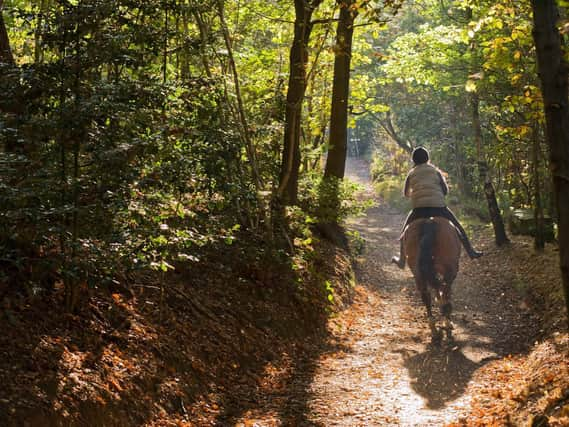Equestrian charity warns off-road routes could be lost if they are not registered before government deadline


According to legislation passed in 2015, the government plans to close the definitive maps – the legal record of public rights of way – to the claim of historic paths which existed before 1949 on January 1, 2026.
This means any regularly used route which falls into this category and is not formally registered by that deadline will be lost to riders, walkers, hikers and cyclists.
Advertisement
Hide AdAdvertisement
Hide AdThe aim of the Bill is to give landowners certainty as to what routes they have over their land.
This also means it is up to the users to ensure the routes they use and love are recorded and will still be there to be enjoyed.
According to the British Horse Society (BHS), in England the public rights of way network amounts to 188,700km, consisting of 146,600km of footpaths, 32,400km of bridleways, 3,700km of byways and 6,000km of restricted byways.
Horse riders have access to 22 per cent with horse-drawn vehicle drivers only five per cent and just because you ride a route it does not mean it is protected. And while it may exist in law, if it has not been registered on the map it is under threat.
Advertisement
Hide AdAdvertisement
Hide AdThe BHS is urging people to register any routes they use which are not on the map and has put together a 2026 Toolkit to help make the process as straightforward as possible.
The first stage of the process is to see if your route is already on the map and this can be done by checking an Ordinance Survey Map to see if the route is marked as a bridleway, restricted bridleway or a byway open to traffic.
If it is, the route is safe. If not the next step is to check the local authority map which can be done online or by contacting the Rights of Way department.
Routes can be logged on the BHS website or the toolkit can be used to put together and submit a Definitive Map Modification Order (DMMO) application.
Advertisement
Hide AdAdvertisement
Hide AdThe steps needed to make a DMMO can be found on the website and through funding from Sport England and the British Equestrian Federation, matched by the charity, there are grants available to anyone who is making an eligible DMMO, not just BHS members, to go toward covering the costs of making an application.
A spokesman for the BHS said: “Our Project 2026 website enables people to identify routes to be researched, and to collate evidence that they have collected. If you wish, you can use it to generate a complete application including a summary document with copies of all the evidence gathered.
“Even if you don’t wish to do this, in order to make Project 2026 as efficient as possible and to avoid unnecessary duplication of effort, we would encourage everyone to add any routes that they are researching and to note if and when they have submitted a Definitive Map Modification Order application for them.
“The guide should help you start using the site and point you to further support if needed.”
Advertisement
Hide AdAdvertisement
Hide AdMark Corrigan, from Kirklees Bridleway Group, used the site to create an application from start to finish, describing it as “user friendly”.
“I had already been using the Project 2026 website for accessing historic maps,” he said.
“Following the National Access Conference in 2019 where I attended the break-out section, Making the best of Project 2026, with Adrian Bigg and Will Steel, I decided to try and create a DMMO from start to finish using the website.
“The system is user friendly and once you have all your evidence on your laptop with screen shots and uploads mastered, you are well on your way.”
Advertisement
Hide AdAdvertisement
Hide AdMr Corrigan said that by using the website he had been able hit his own target for applications.
“It took me two days from start to finish to do my first application using the site.
“I submitted the claim electronically at 8pm on a Sunday and on the Monday morning I went into the council offices to sign the documents and supply them with a physical copy.
“The Rights of Way team were extremely surprised at our efficiency and liked the electronic version as a more environmentally friendly way of applying for a DMMO.
Advertisement
Hide AdAdvertisement
Hide Ad“I did my second application a week later, a little bit quicker than the first.
“This enabled me to hit my personal target I’d set myself of ten applications for the year.”
In 2010, the BHS set up its horse accidents website to log road incidents involving horses. The figures show there have been 43 human deaths and 315 equine deaths.